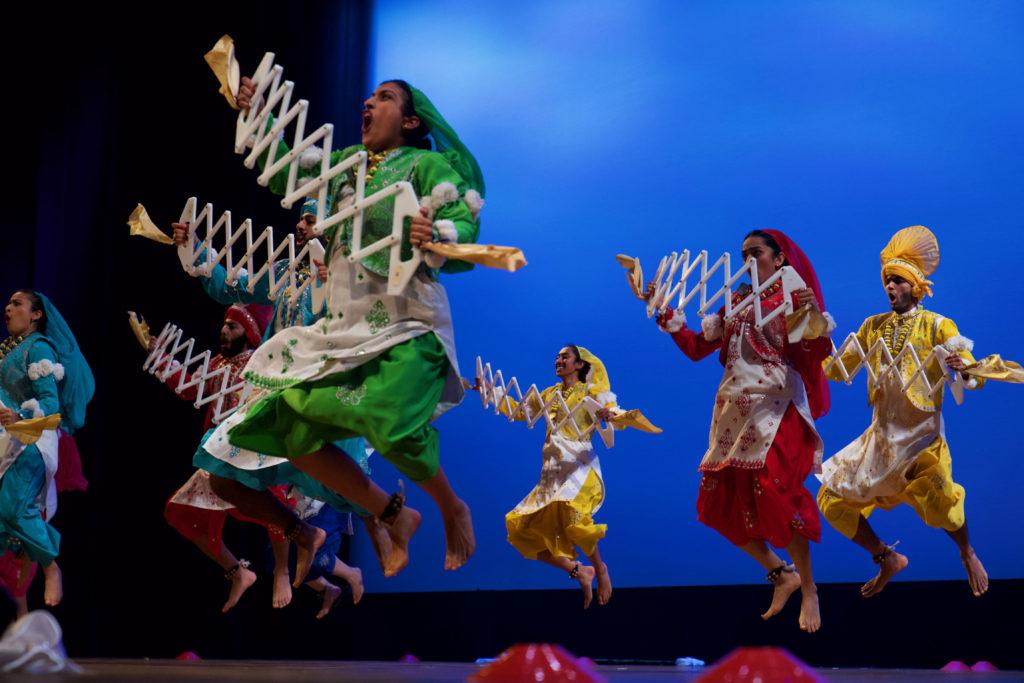Mesmerizing an audience of hundreds with every energetic step, eight collegiate bhangra teams from around the country gathered in Lisner Auditorium Saturday night to compete and perform at this year’s Bhangra Blowout before hundreds of spectators.
Collegiate teams at the competition perform a self-choreographed bhangra routine, a traditional folk dance originating in the Punjab region in Pakistan and India, complete with vigorous kicks, leaps and bends of the body and colorful traditional Indian attire. Mallika Saksena, the co-director of Bhangra Blowout, said the GW South Asian Society hosted the first Blowout in 1993, and it has since grown into one of the largest intercollegiate South Asian dance competitions in North America.
[gwh_image id=”1184693″ credit=”Florence Shen | Staff Photographer” align=”right” size=”embedded-img”][/gwh_image]
Saksena said the organizers sold nearly 1,200 tickets, ranging from $20 to $30, for the performance. Competing teams from the universities of Virginia, Maryland and Michigan, Purdue, Cornell and Carnegie Mellon universities and the Georgia Institute of Technology and Virginia Tech performed to an eager and invigorated audience of students, parents and alumni.
She said GW alum Gautam Gulati founded the Blowout to bring bhangra from Punjab, India to the United States and allow dancers to pass the tradition down from generation to generation. Saksensa said bhangra connects her to age-old traditions surrounding the dance and its practice in South Asian history that she feels bring her closer to her heritage.
“Being a child of immigrants – and I know that a lot of people who were at the competition yesterday are also – we want to be able to keep our parents’ tradition and our family’s traditions close to our heart so that we can pass that down as well,” Saksena said. “This is a beautiful way to do it. Dancing is fun.”
Saksena said her relationship to the South Asian cultural aspects of the dance have only grown stronger because of the enthusiasm from various dance groups on campus and the scale of this event. Other South Asian dance organizations like GW Naach and GW Raas performed as exhibition teams at the event, revving up the crowd.
“I think coming here to GW and seeing this has opened my eyes to the ability that my generation has to continue bhangra in our lives, even though we’re so removed from our ancestors and relatives back home,” Saksena said.
[gwh_image id=”1184695″ credit=”Florence Shen | Staff Photographer” size=”embedded-img” align=”left” /]
Virginia Tech placed first, the University of Maryland placed second and the University of Michigan placed third. Virginia Tech’s performance followed a classroom theme and was set in front of a whiteboard that read “Bhangra 101.” The University of Michigan team brought their own lighting to the show and started the dance with a soundbite from Kanye West’s famous Grammy Speech – “Everybody want to know what I would do if I didn’t win… I guess we’ll never know” that transitioned into traditional Punjabi music. All three teams exhibited an overwhelmingly positive spirit on stage, along with entertaining choreography and skilled execution.
The performances at Bhangra Blowout were set to traditional South Asian music integrated with popular American music. The bhangra dances sometimes incorporated props like the khunda, a 5-foot-long stick that is hooked at the top, and accompanied dynamic and lively songs called boliyan. In some performances, a drummer would bang a beat on a double-headed drum called a dhol.
Huge smiles covered the faces of every dancer, and their charismatic energy was palpable. Each energetic kick, formation transition and dexterous use of props like the khunda inspired cheers and head bobs from the audience.
The dancers showcased impressive talent while performing physically intensive and technically complex routines requiring tremendous amounts of flexibility and strength with ease. The dancers’ hypnotizing synchronism and careful execution made it clear that they put hours of work into training. The performances were also visually engaging, with shiny rhinestones adorning the vibrantly colored, embroidered outfits, including kurtas, a loose shirt and kameezes, a long traditional dress. The choreography made it easy to get lost in the sea of movement and feel completely engulfed in the cathartic and gleeful spirit of the dances.
[gwh_image id=”1184696″ credit=”Florence Shen | Staff Photographer” align=”none” size=”embedded-img”][/gwh_image]
Saksena said to give back to the community, Blowout donated all ticket proceeds to Saahas For Cause, a nonprofit organization that aims to provide mental health resources and education to South Asian immigrants.
Saksena said the judging panel allowed teams to include more creative themes, like Virginia Tech’s classroom setting, in their performances than past years and use modern music. She said in contrast to the emphasis on creativity this year, last year was devoted to returning to the basics of bhangra and executing the traditional dance moves after the COVID-19 pandemic.
“College teams have the basics of bhangra, but they’re still young bhangra dancers, so execution and form and things like that are not perfect yet,” Saksena said. “But if there’s creativity in what they’re doing and they’re pushing themselves to new themes, new bounds, new props, things like that, that’s what the judges really wanted to see this year.”
After the competitive teams performed, three exhibition teams took the stage, followed by the Blowout’s headliner, Fateh Singh, known by his stage name Fateh DOE. Singh is a Toronto-based Canadian rapper, singer and songwriter of Indian descent, known for original songs that fuse modern hip-hop and traditional Punjabi music. He was also a bhangra dancer in college, and Saksensa said the Blowout organizing team was excited to bring the artist to the South Asian community in D.C.
Ria Gupta, the president of GW Naach, the University’s Bollywood fusion dance team which performed as an exhibition team after the competition, said she feels honored to be a part of such a loud and proud South Asian community on campus.
“It just makes me feel very at home and makes me feel that on campus there are people who are there to celebrate my identity and people who take pride in their identity and our identity as a whole,” Gupta said.
Gupta said this year’s turnout delivered the biggest audience Naach has performed in front of, and the energy in the auditorium was “mind-blowing.”
“To just be able to sit in the audience with teams from other schools and to see so many people show up from all different parts of America to be able to perform at our college and to be able to watch us perform was a surreal experience,” Gupta said.





